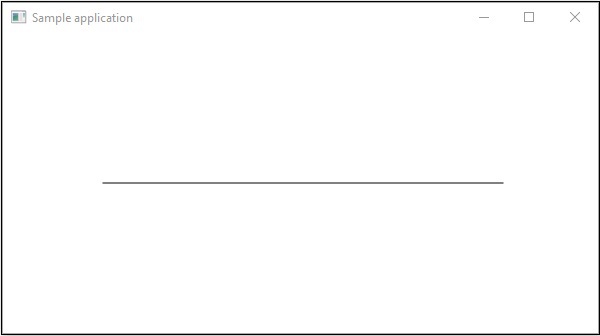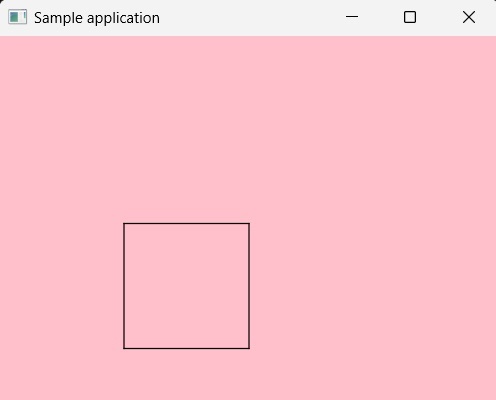
- JavaFX Tutorial
- JavaFX - Home
- JavaFX - Overview
- JavaFX Installation and Architecture
- JavaFX - Installation Using Netbeans
- JavaFX - Installation Using Eclipse
- JavaFX - Installation using Visual Studio Code
- JavaFX - Architecture
- JavaFX - Application
- JavaFX 2D Shapes
- JavaFX - 2D Shapes
- JavaFX - Drawing a Line
- JavaFX - Drawing a Rectangle
- JavaFX - Drawing a Rounded Rectangle
- JavaFX - Drawing a Circle
- JavaFX - Drawing an Ellipse
- JavaFX - Drawing a Polygon
- JavaFX - Drawing a Polyline
- JavaFX - Drawing a Cubic Curve
- JavaFX - Drawing a Quad Curve
- JavaFX - Drawing an Arc
- JavaFX - Drawing an SVGPath
- JavaFX Properties of 2D Objects
- JavaFX - Stroke Type Property
- JavaFX - Stroke Width Property
- JavaFX - Stroke Fill Property
- JavaFX - Stroke Property
- JavaFX - Stroke Line Join Property
- JavaFX - Stroke Miter Limit Property
- JavaFX - Stroke Line Cap Property
- JavaFX - Smooth Property
- Operations on 2D Objects
- JavaFX - 2D Shapes Operations
- JavaFX - Union Operation
- JavaFX - Intersection Operation
- JavaFX - Subtraction Operation
- JavaFX Color and Texture
- JavaFX - Colors
- JavaFX Text
- JavaFX - Text
- JavaFX Effects
- JavaFX - Effects
- JavaFX Transformations
- JavaFX - Transformations
- JavaFX Animations
- JavaFX - Animations
- JavaFX Images
- JavaFX - Images
- JavaFX 3D Shapes
- JavaFX - 3D Shapes
- JavaFX - Creating a Box
- JavaFX - Creating a Cylinder
- JavaFX - Creating a Sphere
- Properties of 3D Objects
- JavaFX - Cull Face Property
- JavaFX - Drawing Modes Property
- JavaFX - Material Property
- JavaFX Event Handling
- JavaFX - Event Handling
- JavaFX - Using Convenience Methods
- JavaFX - Event Filters
- JavaFX - Event Handlers
- JavaFX UI Controls
- JavaFX - UI Controls
- JavaFX - ListView
- JavaFX - Accordion
- JavaFX - ButtonBar
- JavaFX - ChoiceBox
- JavaFX - HTMLEditor
- JavaFX - MenuBar
- JavaFX - Pagination
- JavaFX - ProgressIndicator
- JavaFX - ScrollPane
- JavaFX - Separator
- JavaFX - Slider
- JavaFX - Spinner
- JavaFX - SplitPane
- JavaFX - TableView
- JavaFX - TabPane
- JavaFX - ToolBar
- JavaFX - TreeView
- JavaFX - Label
- JavaFX - CheckBox
- JavaFX - RadioButton
- JavaFX - TextField
- JavaFX - PasswordField
- JavaFX - FileChooser
- JavaFX - Hyperlink
- JavaFX - Tooltip
- JavaFX - Alert
- JavaFX - DatePicker
- JavaFX - TextArea
- JavaFX Charts
- JavaFX - Charts
- JavaFX - Creating Pie Chart
- JavaFX - Creating Line Chart
- JavaFX - Creating Area Chart
- JavaFX - Creating Bar Chart
- JavaFX - Creating Bubble Chart
- JavaFX - Creating Scatter Chart
- JavaFX - Creating Stacked Area Chart
- JavaFX - Creating Stacked Bar Chart
- JavaFX Layout Panes
- JavaFX - Layout Panes
- JavaFX - HBox Layout
- JavaFX - VBox Layout
- JavaFX - BorderPane Layout
- JavaFX - StackPane Layout
- JavaFX - TextFlow Layout
- JavaFX - AnchorPane Layout
- JavaFX - TilePane Layout
- JavaFX - GridPane Layout
- JavaFX - FlowPane Layout
- JavaFX CSS
- JavaFX - CSS
- Media with JavaFX
- JavaFX - Playing Video
- JavaFX Useful Resources
- JavaFX - Quick Guide
- JavaFX - Useful Resources
- JavaFX - Discussion
JavaFX - Drawing a Line
Generally, a line is a geometrical structure which is infinitely long on a multi-dimensional plane (Say, an XY plane). This geometrical figure does not have any start and end points; neither does it have measurable dimensions like width, depth etc. Even though a line is a one-dimensional object, it can still exist in two or higher dimensional planes.
However, a segment of this line with both start and end points, called the "line segment" is used in everyday geometry; which is also the figure that we learn how to create using JavaFX, in this chapter. It is drawn as shown in the image below.

Line in JavaFX
In JavaFX, a line, or a line segment, is represented by a class named Line. This class belongs to the package javafx.scene.shape. By instantiating this class, you can create a line node in JavaFX.
This class has 4 properties of the double datatype namely −
startX − The x coordinate of the start point of the line.
startY − The y coordinate of the start point of the line.
endX − The x coordinate of the end point of the line.
endY − The y coordinate of the end point of the line.
To draw a line, you need to pass values to these properties, either by passing them to the constructor of this class, in the same order, at the time of instantiation.
Steps to Draw a Line in JavaFX
Follow the steps given below to Draw a Line in JavaFX.
Step 1: Creating a Line
You can create a line in JavaFX by instantiating the class named Line which belongs to a package javafx.scene.shape. Instantiate this class as shown below −
//Creating a line object Line line = new Line();
Note that the entire code to implement JavaFX graphics, which includes the instantiation of Line class, must be written within the start() method of Application class, as shown below −
public class ClassName extends Application {
public void start(Stage primaryStage) throws Exception {
// Write code here
Line line = new Line();
}
}
Step 2: Setting Properties to the Line
Specify the coordinates to draw the line on an XY plane by setting the properties startX, startY, endX and endY, using their respective setter methods as shown in the following code block.
line.setStartX(100.0); line.setStartY(150.0); line.setEndX(500.0); line.setEndY(150.0);
Step 3: Adding Line Object to Group
Instantiate the Group class of package javafx.scene, by passing the Line object as a parameter value to its constructor as follows −
Group root = new Group(line);
Step 4: Launching Application
Once the 2D object is created, follow the given steps below to launch the application properly −
Firstly, instantiate the class named Scene by passing the Group object as a parameter value to its constructor. To this constructor, you can also pass dimensions of the application screen as optional parameters.
Then, set the title to the stage using the setTitle() method of the Stage class.
Now, a Scene object is added to the stage using the setScene() method of the class named Stage.
Display the contents of the scene using the method named show().
Lastly, the application is launched with the help of the launch() method.
Example
Following is the program which generates a straight line using JavaFX. Save this code in a file with the name DrawingLine.java.
import javafx.application.Application;
import javafx.scene.Group;
import javafx.scene.Scene;
import javafx.scene.shape.Line;
import javafx.stage.Stage;
public class DrawingLine extends Application{
@Override
public void start(Stage stage) {
//Creating a line object
Line line = new Line();
//Setting the properties to a line
line.setStartX(100.0);
line.setStartY(150.0);
line.setEndX(500.0);
line.setEndY(150.0);
//Creating a Group
Group root = new Group(line);
//Creating a Scene
Scene scene = new Scene(root, 600, 300);
//Setting title to the scene
stage.setTitle("Sample application");
//Adding the scene to the stage
stage.setScene(scene);
//Displaying the contents of a scene
stage.show();
}
public static void main(String args[]){
launch(args);
}
}
Compile and execute the saved java file from the command prompt using the following commands.
javac --module-path %PATH_TO_FX% --add-modules javafx.controls DrawingLine.java java --module-path %PATH_TO_FX% --add-modules javafx.controls DrawingLine
Output
On executing, the above program generates a JavaFX window displaying a straight line as shown below.

Drawing Multiple Lines
You can also draw multiple lines on a single application by grouping all the lines together using addAll() function. An example demonstrating the same is as follows. In here, we are drawing a square using four lines and coloring the background "pink". Save this code in a file with the name DrawingMultipleLines.java.
Example
import javafx.application.Application;
import javafx.scene.Group;
import javafx.scene.Scene;
import javafx.scene.paint.Color;
import javafx.scene.shape.Line;
import javafx.stage.Stage;
public class DrawingMultipleLines extends Application{
@Override
public void start(Stage stage) {
//Creating a line object
Line line1 = new Line();
//Setting the properties to a line
line1.setStartX(100.0);
line1.setStartY(150.0);
line1.setEndX(200.0);
line1.setEndY(150.0);
// Setting Properties to other lines
// without setter methods
Line line2 = new Line(200, 150, 200, 250);
Line line3 = new Line(200, 250, 100, 250);
Line line4 = new Line(100, 250, 100, 150);
//Creating a Group
Group root = new Group();
root.getChildren().addAll(line1,line2,line3,line4);
//Creating a Scene
Scene scene = new Scene(root, 400, 400, Color.PINK);
//Setting title to the scene
stage.setTitle("Sample application");
//Adding the scene to the stage
stage.setScene(scene);
//Displaying the contents of a scene
stage.show();
}
public static void main(String args[]){
launch(args);
}
}
Compile and execute the saved java file from the command prompt using the following commands.
javac --module-path %PATH_TO_FX% --add-modules javafx.controls DrawingMultipleLines.java java --module-path %PATH_TO_FX% --add-modules javafx.controls DrawingMultipleLines
Output
The output window of the program above will be obtained as shown below.
